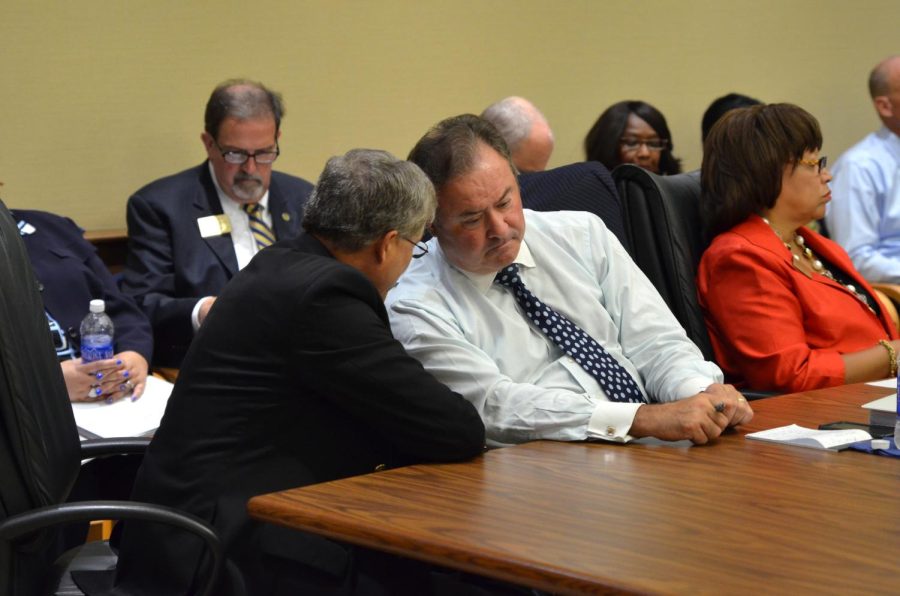Board of Trustees discuss shared vision, continued admissions growth
Chair Dennis Eckard shares a word with Ralph Ratta during the Board of Trustees meeting on Wednesday, Sept. 9, 2015.
September 9, 2015
Kent State’s Board of Trustees approved the shared vision statement presented by President Beverly Warren and debated strategies for handling the university’s growing student numbers in its meeting Wednesday.
Since arriving at Kent State in July 2014, Warren has met with faculty members, students, alumni, donors, trustees and the community to develop a strategy, which addresses the university’s ambitions going forward. Warren unveiled the final draft of the shared vision statement to the board today. The statement reads:“To be a community of change agents whose collective commitment to learning sparks epic thinking, meaningful voice, and invaluable outcomes to better our society.”
Warren said Kent State, currently with record numbers of enrollments student retention and degrees awarded, is at a great moment and plans to develop the university — all eight campuses acting as one — into one of Ohio’s premier higher education institutions, focusing specifically on five key priorities: putting students first, becoming globally competitive, having a regional impact, excelling in stewardship and receiving national distinction for the academic programs and staff.
She also named six peer institutions — Georgia State, Ohio University, Western Michigan, Houston, North Texas and Utah State — Kent State can look at as a measuring point, and four aspirational institutions — Clemson, South Florida, Virginia Commonwealth and Temple — with admirable qualities.
“Peer institutions are universities that have similarities, not all across the board in every category, but similarities that would make our universities compatible in terms of benchmarking and comparing,” Warren said during the presentation. “For aspirational institutions we took a different tactic; we really wanted to look at institutions who have really been on the rise and explore ‘how did they do that? How did they make significant changes in their culture and how they work?’”
Admissions
For the seventh consecutive year, Kent State saw its student population grow, coming in at 28,565 this year (a statistic to be finalized in the 15-day enrollment numbers), up from 28,456 in 2014.
T. David Garcia, senior associate vice president for strategic enrollment management, said Kent State is recruiting a “different type of freshman.”
More students are coming from the top of their high school class, with this year’s incoming freshman with an average 3.35 GPA and an ACT score of 23 (its highest average score,) and they’re coming from a higher socioeconomic status than previous classes.
“Since 2010, the undergraduate student body has grown by 2,000 students,” Garcia said. “This is a really exciting time for Kent State.”
However, Garcia noted the percentage of incoming freshmen at regional campuses decreased, as did students who identify as African-American, Native-American or Latino—just 14.8 percent of students—down from 16.3 percent last year. The board discussed ways to grow that number, including targeting nearby high schools in Cleveland and Akron.
International Students
Todd Diacon, senior vice president for academic affairs and provost, delivered a presentation on developing a residence hall for an international living learning community.
International students compose 11 percent of the student body, originating from 105 different countries.
Diacon said Kent State and Ohio State are the only universities in Ohio with a percentage of international students greater than 10 percent, although this year’s total isn’t readily available yet.
However, a lack of on-campus housing options could prevent that number from increasing unless another option is developed.
He said living learning communities boast the highest GPA (3.07) of the three available living arrangements (standard on-campus housing came in second with a 2.86 GPA and off-campus housing finished third at 2.77.)
The proposed project would cost an estimated $35 to $45 million, $30 to $38 million for the hall, and $5 to $7 million for global education program.
Diacon said the university could have accepted an additional 400 to 800 more international students this year but couldn’t provide them all with a place to live under the current setup.
Warren said she believes “we will become Ohio’s international university.”
Budget Legislation
In response to an Ohio Senate’s challenge for all Ohio four-year institutions to provide in-state undergraduates an opportunity to lower their tuition by five percent over the course of their college career, Diacon proposed a number of options.
He said one-third of the student body entered college with some credit already and that the 18-hour credit cap saved students a collective $1.5 million this year.
The university also offers 54 degrees with roadmaps for three-year completion (with 20 percent more in the coming year,) and two majors based completely online. Diacon also proposed limiting majors to 120 credit hours, unless licensure or accreditation requires more.
The proposed five percent cut would save the average four-year in-state student an estimated $5,000.
Notes:
-
The Board of Trustees approved a resolution celebrating the career of Gregg Floyd, vice president for finance and administration, who is retiring June 30, 2016.
-
President Warren announced the second coming of her listening tour, this time titled “Forums for the Future.”
-
The board also approved the naming of the football player lounge in honor of football player Jason Bitsko, who died in Aug. 2014.
Ian Flickinger is sports editor for The Kent Stater. Contact him at [email protected].

























